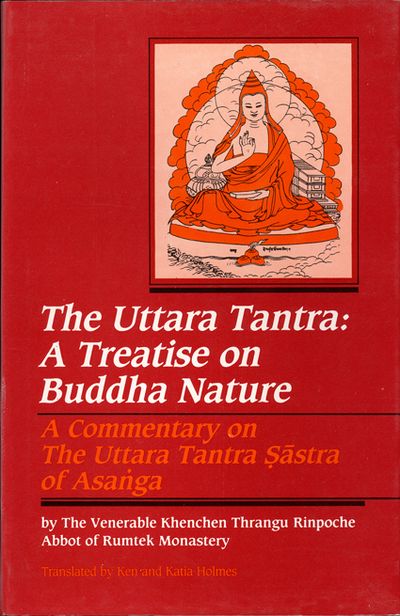The Uttara Tantra: A Treatise on Buddha Nature
No edit summary |
No edit summary |
||
| (5 intermediate revisions by the same user not shown) | |||
| Line 14: | Line 14: | ||
}} | }} | ||
|FullTextRead=No | |FullTextRead=No | ||
|BookToc=* {{i|''Foreword''|VII}} | |||
|BookToc=* {{i|Foreword|VII}} | |||
* {{i|Chapter 1 An Introduction to the ''Uttar Tantra''|1}} | * {{i|Chapter 1 An Introduction to the ''Uttar Tantra''|1}} | ||
* {{i|Chapter 2 The Buddha|21}} | * {{i|Chapter 2 The ''Buddha''|21}} | ||
* {{i|Chapter 3 The Dharma|28}} | * {{i|Chapter 3 The ''Dharma''|28}} | ||
* {{i|Chapter 4 The Sangha|39}} | * {{i|Chapter 4 The ''Sangha''|39}} | ||
* {{i|Chapter 5 An Introduction to Book II:<br> The Last Four Vajra Points|49}} | * {{i|Chapter 5 An Introduction to Book II:<br> ''The Last Four Vajra Points''|49}} | ||
* {{i|Chapter 6 Buddha Nature : The Ten Aspects|54}} | * {{i|Chapter 6 Buddha Nature: ''The Ten Aspects''|54}} | ||
* {{i|Chapter 7 Buddha Nature II: The Nine Examples|85}} | * {{i|Chapter 7 Buddha Nature II: ''The Nine Examples''|85}} | ||
* {{i|Chapter 8 Enlightenment|102}} | * {{i|Chapter 8 ''Enlightenment''|102}} | ||
* {{i|Chapter 9 The Qualities of Buddhahood|145}} | * {{i|Chapter 9 ''The Qualities of Buddhahood''|145}} | ||
* {{i|Chapter 10 Buddha Activity|165}} | * {{i|Chapter 10 ''Buddha Activity''|165}} | ||
* {{i|Chapter 11 The Benefits of the Text|180}} | * {{i|Chapter 11 ''The Benefits of the Text''|180}} | ||
* {{i|Glossary|191}} | * {{i|''Glossary''|191}} | ||
* {{i|Appendix A|199}} | * {{i|''Appendix A''|199}} | ||
|AddRelatedTab=Yes | |AddRelatedTab=Yes | ||
|PostStatus=Needs Copy Editing | |PostStatus=Needs Copy Editing | ||
|StopPersonRedirects=No | |||
|BookParentPage=Library | |BookParentPage=Library | ||
}} | }} | ||
Latest revision as of 17:40, 16 September 2020
The Uttar Tantra like many other texts of the time was written in very terse, compact language with extremely deep and subtle references which makes the text accessible to only an extremely erudite scholar. This book follows an oral tradition used by lamas for the last ten centuries which meant that every point was numbered, placed in a category, stated, restated, emphasized, and then summarized. Thrangu Rinpoche spent several months giving a line by line commentary on this Uttar Tantra. Had the transcript simply been typeset, the commentary would have been about 700 pages long and would have been very difficult to follow. So with the help of chapters, headings, and extensive elimination of repetition and categorization, the Uttar Tantra was brought down to a manageable size which could be easily read by Westerners. A glossary and appendix of Tibetan terms were also added for the reader not familiar with Buddhist terms. A commentary have also been made so that the reader could read it without having to refer to the root text. The result is quite extraordinary. We have a complete rendering of an intact text of the period by someone who not only has studied it for a lifetime, but who has done the same meditative practices that Asaṅga did to reach the realization described in the text. ln addition to this we have Thrangu Rinpoche’s line by line exposition explaining every word of the text. The covering of a text with this precision with the guide of Kongtrul's shastra which has to be one of the greatest commentaries on any religious text of this period is something which has been available to only a few rare individuals living over the past centuries in monasteries in Tibet. (Source: Exotic India)
| Citation | Thrangu Rinpoche. The Uttara Tantra: A Treatise on Buddha Nature; A Commentary on The Uttara Tantra Ṣāstra of Asaṅga. Translated by Ken Holmes and Katia Holmes. Bibliotheca Indo-Buddhica Series 131. Delhi: Sri Satguru Publications, 1994. https://archive.org/details/uttaratantraatreatiseonbuddhanaturecommentaryofasangathrangukhenchenrinpochesatguru_202003_3_y/mode/2up. |
|---|---|

